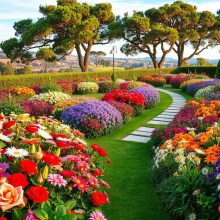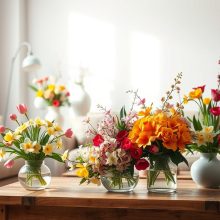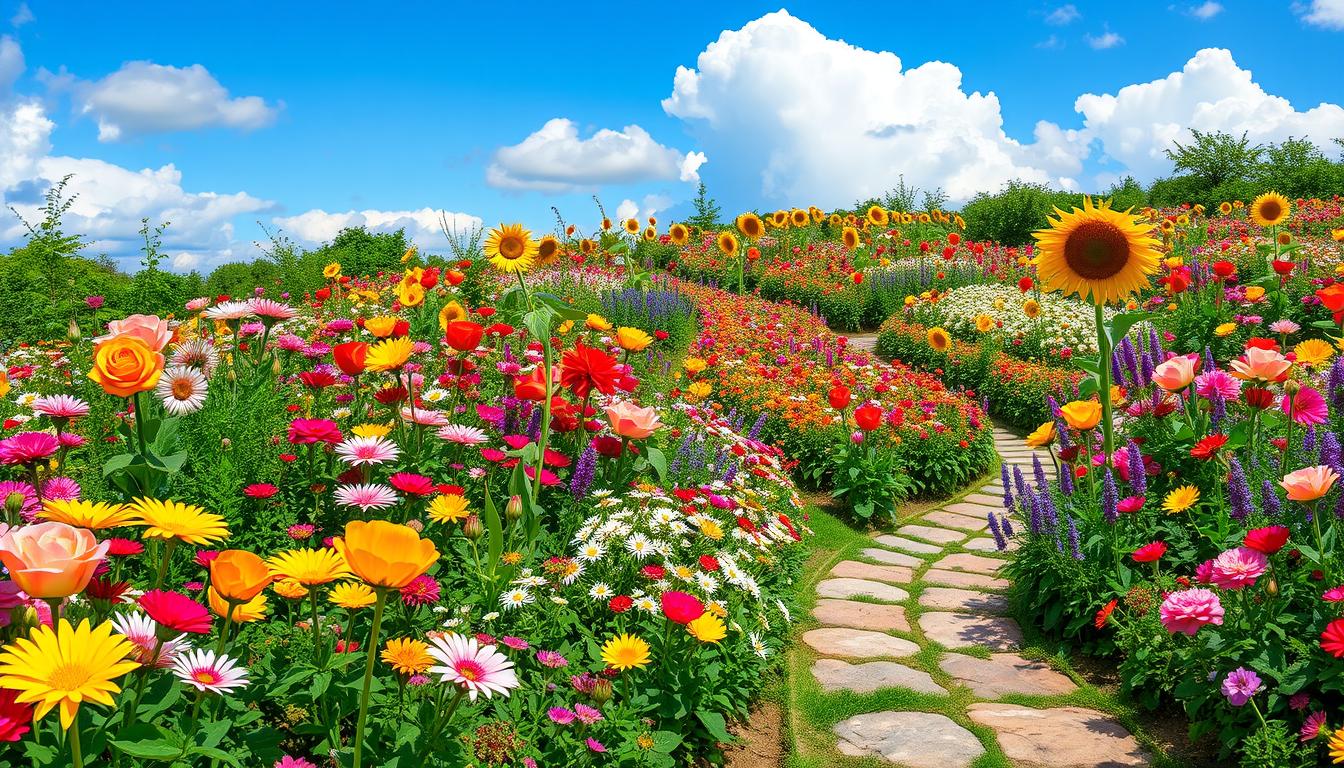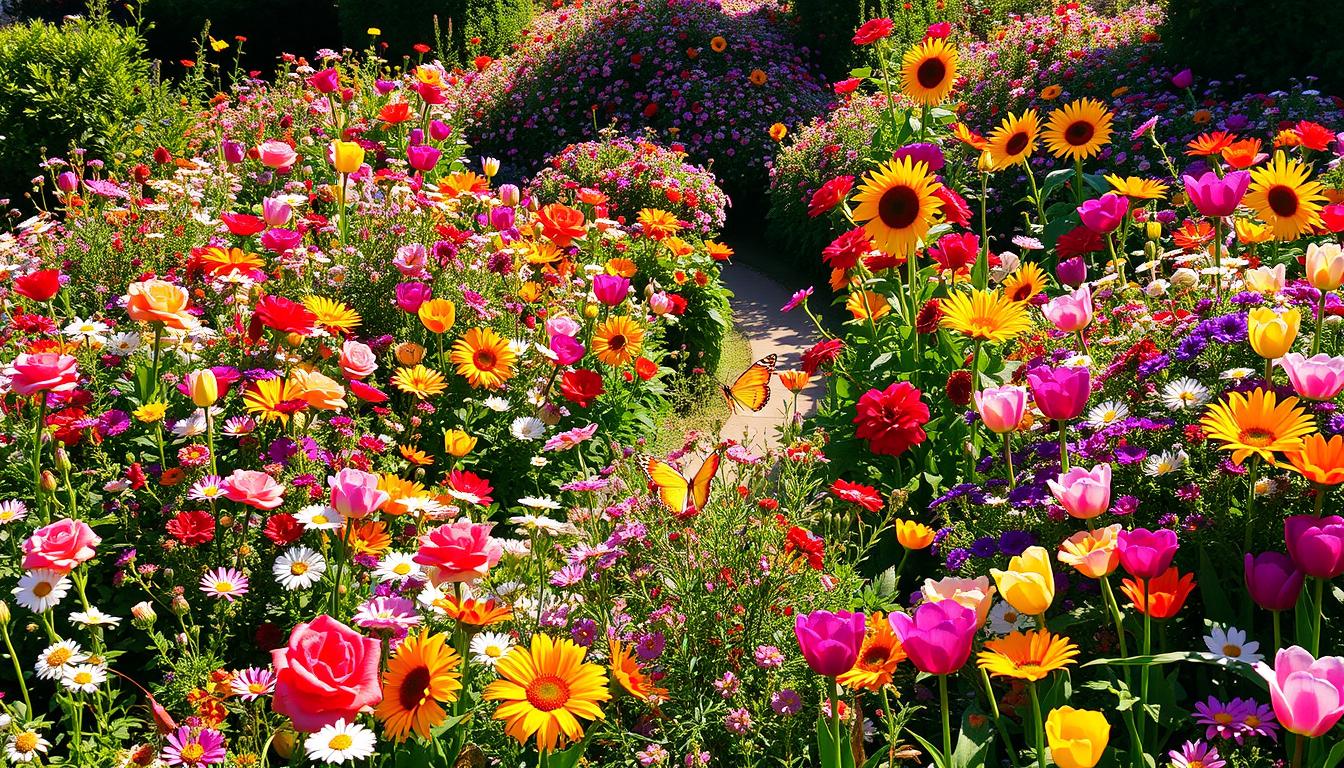Transform Your Garden with Beautiful Flower Bed Ideas
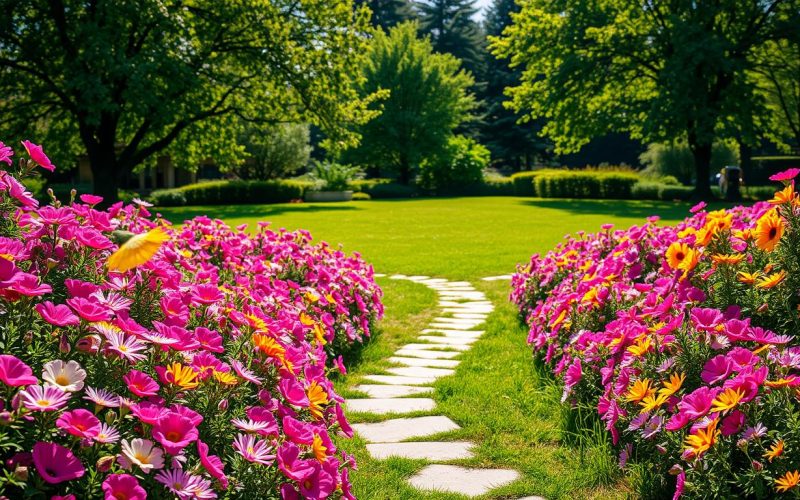
Creating stunning flower bed ideas can turn your outdoor space into something amazing. Garden bed designs add color, texture, and personality to your landscape. They can make even a small yard or a big garden look better.
Flower beds are more than just decorations. They are living art that changes with the seasons. They add beauty and connect your home to nature. Professional landscapers know that good garden designs can make your property more valuable and welcoming.
Key Takeaways
- Flower beds enhance outdoor aesthetic appeal
- Strategic design can transform landscape appearance
- Different styles suit various garden types
- Flower beds can increase property value
- Creative designs reflect personal style
Choosing the Right Location for Your Flower Bed
Starting with the perfect spot is key to beautiful flowerbeds. The right location can turn a simple garden into a stunning outdoor space. Planning and placement are crucial for a thriving flower bed.
Before you start, think about your garden’s unique features. Choosing the right spot for your flower bed requires careful thought.
Sunlight Requirements
Knowing your garden’s sunlight is important for picking flowers. Different plants need different amounts of sunlight:
- Full sun plants need 6-8 hours of direct sunlight daily
- Partial shade plants thrive with 3-6 hours of sun
- Full shade plants require minimal direct sunlight
Soil Conditions
Soil quality is crucial for flowerbed success. A simple soil test can tell you:
- Soil pH levels
- Drainage capabilities
- Nutrient composition
Accessibility and Visibility
Think about practical things like maintenance and how it looks. Pick spots that are:
- Easy to reach for watering and care
- Visible from key viewing areas
- Complementary to existing landscape features
By considering these factors, you’ll create a flower bed that’s not only beautiful but also healthy.
Selecting the Right Flowers for Your Flower Bed
Creating a stunning flower garden needs careful planning and choosing the right flowers. Understanding how plants work together is key. Your flower planting patterns can turn an ordinary garden into a breathtaking sight that pleases the senses.
When designing your flower bed, consider several important factors. These will affect your plant choices and the garden’s look.
Perennials vs. Annuals: Understanding Your Options
Choosing the right mix of plants is vital for a lively garden. Here’s a quick guide:
- Perennials: Come back year after year, giving steady structure
- Annuals: Provide bold color and the chance to change your design
- Combination planting: Adds depth and continuous blooms
Complementary Color Schemes
Color is crucial in flower garden design. Here are some color pairing tips:
- Monochromatic: Uses different shades of one color
- Complementary: Pairs colors that are opposite each other on the color wheel
- Analogous: Uses colors next to each other on the color wheel
Height and Texture Considerations
Good flower planting patterns mix plants of different heights and textures. Place tall plants in the back, medium-height in the middle, and short ones in the front. This creates a beautiful layered look. Also, mix plants with different leaf shapes and sizes to add interest and depth.
Designing the Layout of Your Flower Bed
Creating stunning garden bed designs requires careful planning and artistic vision. Your flower bed layout can transform an ordinary outdoor space into a breathtaking landscape. It captures attention and reflects your personal style.
Flower bed ideas start with understanding the fundamental principles of garden design. The visual appeal of your garden depends on how you arrange and organize your plants.
Straight Lines vs. Curved Beds
When exploring garden bed designs, you’ll encounter two primary layout approaches:
- Straight-edged beds: Perfect for formal, structured landscapes
- Curved beds: Ideal for creating soft, natural-looking gardens
Straight lines provide a clean, modern aesthetic. Curved beds offer a more organic and relaxed feel. Your choice should complement your home’s architectural style and existing landscape.
Layering Plants for Depth
Successful flower bed ideas rely on strategic plant layering. Create visual interest by positioning plants based on their height:
- Tall plants in the back
- Medium-height plants in the middle
- Low-growing ground cover in the front
This technique ensures every plant receives adequate sunlight. It creates a lush, dimensional appearance.
Focal Points in Your Design
Elevate your garden bed designs by incorporating focal points. Consider adding unique elements like sculptural plants, decorative stones, or garden ornaments. These elements draw the eye and create visual interest.
Remember, a well-designed flower bed tells a story and reflects your creativity. Experiment with different layouts to discover what speaks to your personal gardening style.
Seasonal Flower Bed Ideas for Year-Round Enjoyment
To make a garden lively all year, you need good planning and the right plants. By picking the right mix, your garden can change with the seasons. It will keep looking great from spring to winter.
Getting inspiration for your garden means knowing what each season can offer. You can design beds that change with the seasons, showing off different colors and looks.
Spring Blooms: Awakening the Garden
Spring brings color and life to your garden. Think about planting:
- Tulips in bright colors
- Daffodils with sunny yellow
- Crocus for early ground cover
- Hyacinths for a sweet scent
Summer Color Explosion
Summer turns your garden into a colorful scene. Choose heat-resistant perennials for a stunning look:
- Lavender with purple-blue spikes
- Coneflowers in pink and orange
- Black-eyed Susans for bright yellow
- Salvia for elegant height
Autumn and Winter Interest
To keep your garden beautiful all year, add plants with interesting textures and shapes. Choose ornamental grasses, plants with colorful bark, and perennials with striking seed heads. They’ll keep your garden looking good even in cooler months.
Creating a Cottage Garden Flower Bed
Cottage garden beds bring a romantic and whimsical feel to any outdoor space. They offer a relaxed, abundant garden style that feels timeless and personal. These flower bed ideas capture the essence of a garden that feels both charming and natural.
The secret to successful cottage garden beds is embracing an informal, layered approach. This celebrates natural beauty and abundant plantings. Unlike rigid traditional garden designs, these spaces invite creativity and personal expression.
Classic Flower Choices
Choose flowers that embody the cottage garden aesthetic with these stunning options:
- Romantic roses in soft pastel shades
- Delicate foxgloves with their elegant spires
- Cheerful daisies for pure simplicity
- Lavender for fragrance and texture
- Delphinium in rich blue tones
Incorporating Herbs and Vegetables
Cottage garden beds shine when mixing ornamental plants with practical herbs and vegetables. Add edible plants like rosemary, thyme, and colorful Swiss chard. This creates a garden space that’s both beautiful and productive.
Designing for a Relaxed Look
Create a naturally beautiful cottage garden by letting plants intermingle and grow. Avoid strict geometric patterns. Instead, let flowers and herbs create soft, overlapping textures. This invites exploration and captures the essence of an enchanting, lived-in garden.
Modern Minimalist Flower Bed Ideas
Minimalist landscaping with flowers brings elegance to garden design. It focuses on simplicity. These ideas turn outdoor spaces into sleek, modern areas that stand out with less fuss.
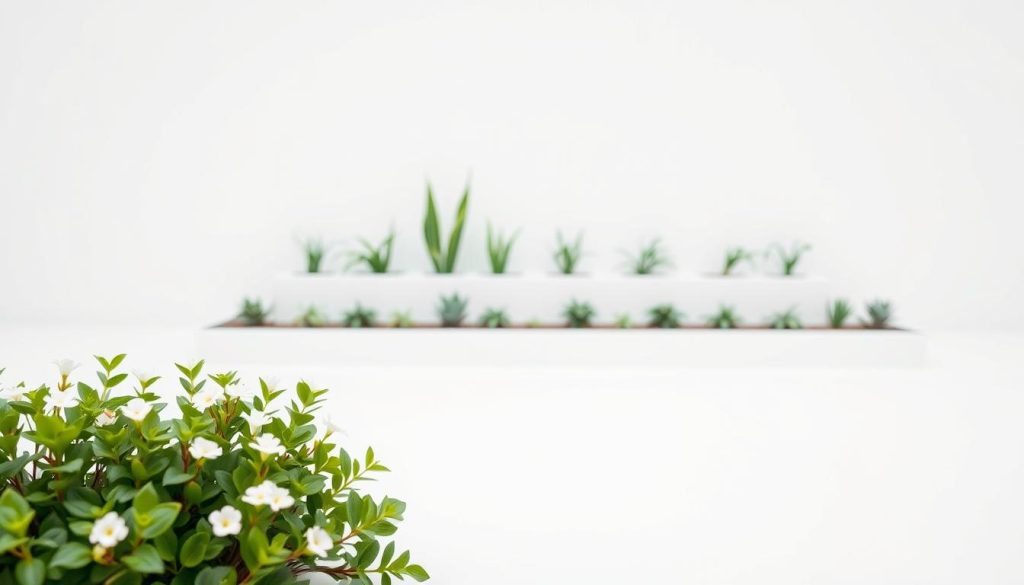
Today’s garden designs aim for clean lines and smart plant choices. The secret to great minimalist flower beds is using plants that make a statement. This is done with careful design.
Simple Plant Selections
For minimalist flower bed ideas, pick these plants:
- Ornamental grasses with unique shapes
- Succulents with geometric forms
- Structural perennials with clear outlines
- Plants that grow evenly in height
The Use of Space and Lines
Minimalist landscaping needs careful planning of space. Use lines to guide the eye. Choose shapes like rectangles or squares for your flower bed edges.
Monochromatic Color Schemes
Monochromatic designs are striking. Choose plants in one color but vary their textures and heights. White, green, and silvery-blue colors are perfect for modern gardens.
Incorporating Native Plants in Your Flower Bed
Native plants are a key to stunning, easy-to-care-for flowerbeds. They turn gardens into lively spots that help local wildlife and inspire gardeners.
Benefits of Native Flora
Native plants are great for gardeners wanting to care for the earth. They grow well in local weather, needing little care and water. These plants do well with:
- Less water needed
- Less need for fertilizers
- Strong against local pests
- Lower costs for upkeep
Sustainable Practices
Using native plants shows you care about the environment. They make strong, balanced ecosystems. This means less need for harmful chemicals and artificial help.
Attracting Pollinators and Wildlife
Native flower beds are homes for important animals. Butterflies, bees, and birds love these plants. By choosing local flowers, you create lively spaces that help nature and look beautiful.
Flower Bed Ideas for Small Spaces
Turning small outdoor spots into lively gardens needs creativity and smart designs. Even the smallest areas can become beautiful green spots with the right ideas and planning. Think vertically and use every inch to make the most of tiny spaces.
Vertical Gardening Techniques
Vertical gardening is a great way to make the most of small spaces. These ideas can greatly increase your growing area without taking up ground space. Here are some techniques to try:
- Install wall-mounted planters with cascading flowers
- Use trellises for climbing plants like clematis and jasmine
- Create hanging basket displays with colorful petunias
- Implement tiered planter systems on balconies or patios
Container Gardening Options
Container gardening is perfect for small areas. Pick containers that match your outdoor style and help plants grow well. Light, easy-to-move pots let you try out different layouts and move plants as you like.
- Choose containers with proper drainage
- Mix different pot sizes for visual interest
- Select compact plant varieties suited to container growing
- Use lightweight potting soil for optimal plant health
Utilizing Corner Spaces
Corner spaces are often ignored but can be turned into lovely garden spots. Smart flower bed ideas can make these areas stand out. Triangular or curved planters are great for corners, adding interest without taking up too much space.
- Install corner shelving for small potted plants
- Use triangular raised bed designs
- Select plants with varying heights for depth
- Include trailing plants to soften hard edges
Family-Friendly Flower Bed Ideas
Creating a flower garden for kids and parents needs careful planning. It’s about making outdoor spaces magical and educational. This way, gardens become places where kids learn while enjoying nature.
Designing a garden for kids means picking the right plants and making interactive areas. The goal is to make a garden that’s safe, teaches, and looks great.
Safe Flower Selections
When picking flowers for a family garden, safety is key. Choose plants that are safe for kids and can handle their play:
- Sunflowers: Tall, sturdy, and exciting for children
- Marigolds: Bright, robust, and easy to grow
- Zinnias: Colorful and resilient to gentle touches
- Snapdragons: Interactive flowers kids love to squeeze
Interactive Planting Activities
Get kids involved in gardening by making it fun. Create a special area for kids to plant, water, and watch their flowers grow.
- Create a butterfly garden section
- Build a sunflower house
- Design sensory plant zones
Educational Opportunities for Kids
Flower gardens can teach kids more than just about plants. They can learn about life cycles, pollination, and caring for the environment through hands-on experiences.
- Track plant growth measurements
- Observe insect interactions
- Learn about plant care and responsibility
A family-friendly flower garden is more than a pretty view. It’s a place where kids can learn, grow, and connect with nature.
Low-Maintenance Flower Bed Solutions
Creating beautiful flower beds doesn’t have to take up all your time. Low-maintenance flowerbeds are great for busy gardeners. They want stunning landscapes with little effort. The right strategies can make your flower bed ideas look amazing with less work.
Drought-Resistant Plants for Easy Care
Choosing the right plants is key for low-maintenance flowerbeds. Here are some drought-resistant options that need little water:
- Lavender – fragrant and resilient
- Sedum – succulent with colorful blooms
- Black-Eyed Susan – native wildflower
- Yarrow – tough perennial with diverse colors
- Coneflower – attracts pollinators
Mulch and Ground Cover Strategies
Mulch is a powerful tool in low-maintenance flower bed ideas. It keeps soil moist, stops weeds, and controls ground temperature. Organic mulches like bark chips or pine straw are not only pretty but also improve soil as they break down.
Smart Watering Practices
Smart watering can cut down garden work a lot. Drip irrigation systems send water straight to roots, saving water. Planting similar water needs together makes your garden easier to care for.
With these low-maintenance tips, you can have beautiful flower beds without spending hours on them. Choosing the right plants, smart design, and efficient watering will turn your garden into a stunning, easy-care space.
Flower Bed Ideas for Shade Areas
Shaded garden spaces can be tricky for gardeners. Many struggle to make vibrant flower beds in the dark. But, there are many ideas to turn these spots into stunning displays full of color and life.
Shade gardens are full of possibilities for garden inspiration. The trick is picking the right plants for the dark and using design to make it look great.
Best Shade-Tolerant Flowers
Some flowers do well in the shade and can make amazing displays:
- Impatiens – vibrant colors perfect for darker areas
- Begonias – beautiful blooms with diverse leaf patterns
- Hostas – stunning foliage with minimal light requirements
- Ferns – elegant texture for woodland-inspired gardens
- Astilbe – delicate plume-like flowers
Design Techniques for Shady Spots
For successful shade flower beds, plan carefully. Use light-colored flowers to brighten dark spots. Add reflective elements like white stones or metallic accents to bounce light and add interest.
Mixing Light and Dark Foliage
Try mixing different leaf colors and textures for depth in your shade garden. Use plants with variegated leaves, silver-green foliage, and deep green backgrounds for a lively design.
With the right plants and creative design, shade areas can be the highlight of your garden. Use these strategies to turn overlooked spaces into lush, beautiful spots.
Incorporating Hardscaping in Your Flower Bed
Landscaping with flowers becomes magical when you mix natural elements with structured design. Hardscaping turns simple flower beds into beautiful outdoor spaces. It adds visual interest and defines garden areas with purpose.
Hardscaping can make your flower bed ideas shine. It adds beauty and function to your garden. By adding non-plant elements, you can enhance your garden’s look and use.
Adding Pathways and Edging
Garden pathways are both useful and pretty. Think about using these materials for your paths and edges:
- Natural stone pavers
- Brick borders
- Wooden railroad ties
- Decorative concrete blocks
The Role of Decorative Stones
Decorative stones can change your flower bed ideas. They add texture and depth. Choose stones that match your garden’s colors and design.
- River rocks for smooth, rounded appearance
- Slate chips for angular, modern look
- Granite boulders as focal points
Water Features and Flower Beds
Water features make your garden stand out. Small fountains or rock-lined streams add soothing sounds. They also attract beneficial wildlife to your garden.
When designing your hardscaped flower bed, balance structure with plants. This creates a welcoming outdoor space.
Enhancing Curb Appeal with Flower Beds
Start transforming your home’s look with flower borders. These can make your property stand out and feel welcoming. They catch the eye of everyone who walks by.
For a great front yard, plan carefully and design thoughtfully. Use flower beds to soften your home’s look, frame entryways, and highlight stunning views. This can make your whole property look better.
Strategic Placement for Maximum Impact
- Position flower beds near main entry points
- Create symmetrical designs around walkways
- Frame architectural features like windows and porches
- Use flower beds to direct visual attention
Color Coordination with Your Home
Choose flower colors that match your home’s paint. Soft pastels look great with neutral houses, while bright flowers add excitement to simple ones. Use the color wheel to pick flowers that go well together.
Seasonal Updates for Fresh Looks
- Plant spring bulbs for early color
- Rotate summer annuals for continuous blooming
- Include autumn-flowering plants for extended interest
- Select evergreen elements for winter structure
By using these flower bed tips, you can make your yard look amazing all year. This will not only make your home look better but also might increase its value.
DIY Flower Bed Projects for Enthusiasts
Gardening fans can make their outdoor areas special with creative flower bed ideas. DIY garden bed designs let you create unique landscapes that show your creativity and love for gardening.
Building your own flower beds is easy. You just need basic tools and a bit of imagination. This way, you can make beautiful garden spaces that will wow your neighbors and make your outdoor area happier.
Building Raised Flower Beds
Raised flower beds are great for gardeners. They help with drainage, soil control, and make gardening easier. Here’s how to make your own raised garden bed:
- Select untreated wood or cedar for durability
- Measure and cut boards to desired dimensions
- Create a sturdy frame using deck screws
- Line the bottom with landscape fabric
- Fill with high-quality gardening soil
Creating Flower Bed Borders
Defining your flower bed edges can make your garden look better. Try using different materials for your garden bed designs, like:
- Natural stone
- Reclaimed brick
- Decorative concrete blocks
- Wooden railroad ties
- Recycled glass bottles
Upcycling for Unique Planters
Turn old things into amazing flower bed containers. Old wheelbarrows, wooden pallets, vintage containers, and even old boots can look great in your garden with a little creativity.
Choose materials that fit your garden’s look and ensure they drain well for healthy plants. Your DIY flower bed projects will save you money and make your outdoor space your own.
Expert Tips for Maintaining Your Flower Bed
To keep your flower beds looking great, you need to care for them regularly. Low-maintenance flowerbeds come from smart care methods. These help your garden grow well with little effort.
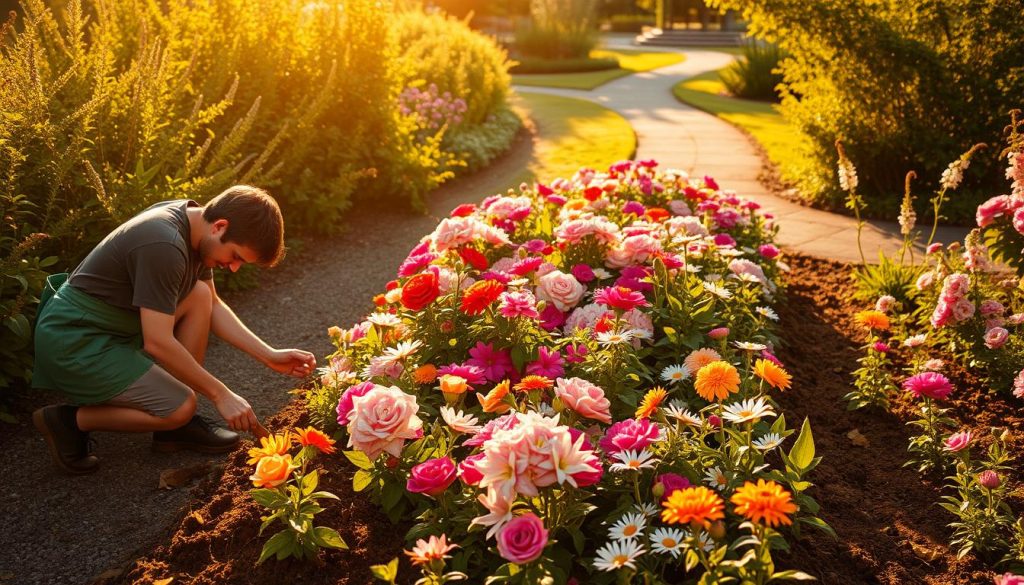
For your flower beds to succeed, you must know the basics of care. These practices keep your plants in top shape all season long.
Pruning and Deadheading Techniques
Pruning is key for healthy plants and more blooms. Deadheading encourages new flowers and saves energy on old ones.
- Remove dead or diseased plant sections
- Cut back perennials after flowering
- Pinch off faded flower heads to stimulate new growth
Fertilization Best Practices
Right fertilization gives plants the nutrients they need. Pick fertilizers that match your flowers and apply them when needed.
- Test soil nutrients annually
- Use slow-release organic fertilizers
- Apply fertilizer during active growing seasons
Pest Control Methods
Keeping pests away from your flower beds is important. Use green and smart ways to fight pests and protect your garden.
- Identify pests early
- Use natural predators when possible
- Apply targeted organic treatments
With these expert tips, you can have stunning, easy-to-care-for flowerbeds. They’ll look amazing with just a little care.
Conclusion: Designing Your Ideal Flower Bed
Creating stunning flower bed ideas is like painting a masterpiece. It turns simple outdoor areas into breathtaking gardens. You can find inspiration everywhere, from nature to botanical gardens, or even in magazines.
Your personal style is crucial in making flower beds unique. Every gardener has their own way of choosing plants, picking colors, and arranging them. Your garden should show off your personality and taste.
Don’t be shy to try new things in your garden. Mix different plants, experiment with textures, and break the rules. Each season is a chance to improve and learn from your experiences.
Flower bed ideas are all about enjoying yourself and connecting with nature. Enjoy the journey, stay open-minded, and remember gardening is always evolving. Your garden can grow and change with your creativity and love for beauty.
